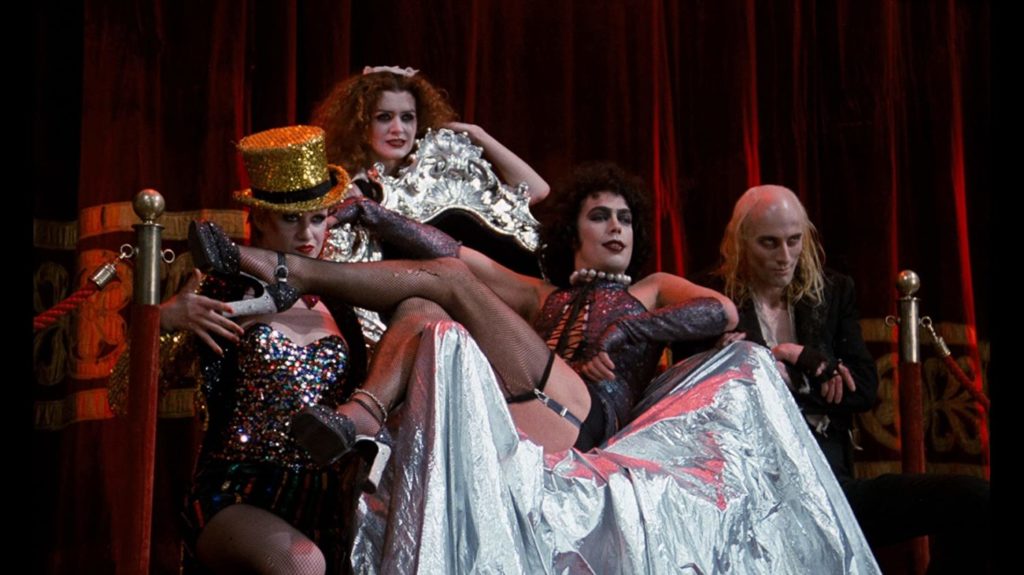There are a lot of interviews spread throughout the new three-part documentary, Time Warp: The Greatest Cult Films of All-Time, but one of the best moments is when the late, great director Tobe Hooper, who died in 2019, talks about the time he called the MPAA to try to garner a PG rating for his new horror film, The Texas Chainsaw Massacre.
“I would make a phone call and say, ‘So, uh, how can I hang a girl on a meat hook and get a PG rating?’” Hooper shrugs with a wry detachment before continuing, “And they said, ‘Well… umm… you can’t.’” With biting perfection and insouciant timing, Hooper’s interview reveals how badly he yearned for his small, macabre gem to be seen by everyone, not just a select few, revealing how one of the nastiest cult films of all time — which played in sticky-floored grindhouse theaters next to porn flicks — was never meant to have “cult” status at all.

ROCKY HORROR PICTURE SHOW (20th Century Fox)
It’s a running theme in Time Warp that filmmakers behind these underground classics never actually set out to make cult films at all; most of the films cited in the series were box-office failures when they were released. So, what happened? How did these deranged artifacts of unlikely fanfare become such an important part of our collective mindset, forever cementing them into pop culture? This is a question Time Warp tackles through a slew of interviews, behind-the-scenes anecdotes and ongoing commentary from actors, filmmakers, musicians, professors and critics. The odyssey through this three-part series, which will be shown On-Demand and via several digital VOD platforms, is a little jarring and all over the place, but then again so are cult films.
In an attempt to present a concise and somewhat pedagogical history of the cult film, director Danny Wolf covers the gamut of the genre, starting with films like Todd Browning’s Freaks from 1935 and ending in the early-2000’s with gross-out shitshows like The Human Centipede. Luckily, Time Warp doesn’t cite these films chronologically (that would be a little too didactic), but otherwise categorizes them under their subject matter.
Volume One, which premiered on April 21, dives into Midnight Madness greats like The Rocky Horror Picture Show, Pink Flamingoes and The Big Lebowski — phenomenons that have garnered a fanatical fanbase. Volume Two focuses on Horror and Sci-Fi (out May 19), two genres that have cranked out more lurid and strange content than a porn studio in Chatsworth. And finally, Volume 3, which explores the varied, at times deranged realm of Comedy and Camp (out June 23). Each chapter is hosted by Hollywood luminaries Joe Dante, Illeana Douglass, John Waters and Kevin Pollack. After the panel discusses the nature of the cult film, each movie is subsequently dissected, analyzed and celebrated by critics, actors and the filmmakers who were a part of its creation.
Although Time Warp’s subject matter is endlessly intriguing, intermittently the series stalls and sputters due to “talking-head” syndrome. And there are a lot of them. Some of the interviews are electric (Gary Busey is still demented); some of them are pretty bland. Thankfully, Wolf’s directing keeps things moving smoothly. He doesn’t stay with one film for too long, and he simultaneously never rushes us through it. However, some of the interviews pass listlessly and you have to snap out of it to stay engaged.
Frankly, Time Warp would’ve benefited from digging a little deeper into the cult film ouvre. Most of the films featured here are so universally renowned and celebrated (Office Space, Napoleon Dynamite, Spinal Tap), there’s not much left to say. It’s obviously an introductory course into the cinema of strange: Cult 101, if you will. And that’s fine, especially since there are mentions of some lesser known gems such as a section on Liquid Sky, the 1982 drug-induced, post-punk masterpiece. The subtitle says, The Greatest Cult Films of All-Time, and that’s certainly what this collection explores. Still, the series could’ve used a Last American Virgin or Zombie to spice things up, and truly expound on the shock and awe that makes this genre thrive in the first place.
Ultimately, there are enough revealing moments in the series to distinguish it from similar fare like AMC’s 100 Scariest Movie Moments (talking head syndrome at its drollest). For example, who knew that famed punk rocker Darby Crash from The Germs can be seen rocking in the front row of The Ramones concert in Rock ‘n’ Roll High School? Or that Valley Girl’s director Martha Coolidge originally wanted X as the house band in the Hollywood sequences (an honor that eventually went to The Plimsouls). Or as John Doe from X relates, “We read the script and thought, ‘this is a dumb fucking movie, why would be want to be in that?’”
Advertising disclosure: We may receive compensation for some of the links in our stories. Thank you for supporting Irvine Weekly and our advertisers.

